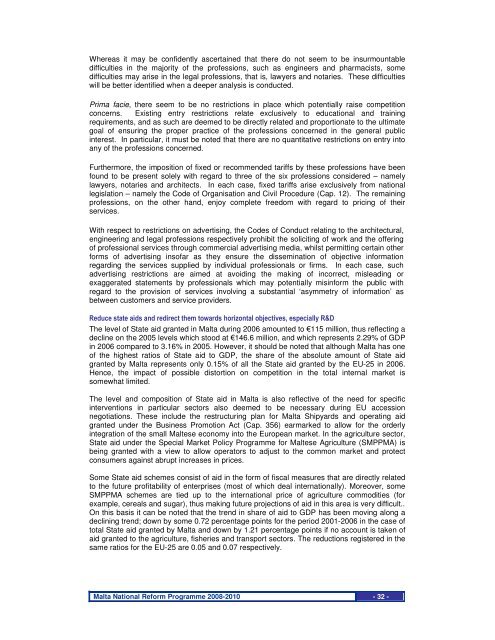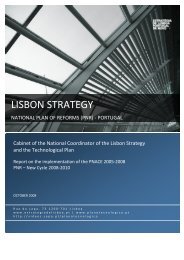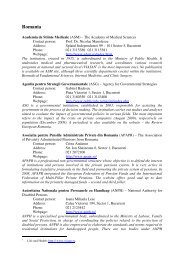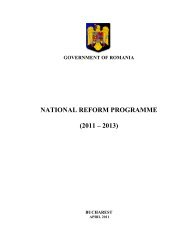National reform programme 2008-2010 Malta - European Commission
National reform programme 2008-2010 Malta - European Commission
National reform programme 2008-2010 Malta - European Commission
Create successful ePaper yourself
Turn your PDF publications into a flip-book with our unique Google optimized e-Paper software.
Whereas it may be confidently ascertained that there do not seem to be insurmountable<br />
difficulties in the majority of the professions, such as engineers and pharmacists, some<br />
difficulties may arise in the legal professions, that is, lawyers and notaries. These difficulties<br />
will be better identified when a deeper analysis is conducted.<br />
Prima facie, there seem to be no restrictions in place which potentially raise competition<br />
concerns. Existing entry restrictions relate exclusively to educational and training<br />
requirements, and as such are deemed to be directly related and proportionate to the ultimate<br />
goal of ensuring the proper practice of the professions concerned in the general public<br />
interest. In particular, it must be noted that there are no quantitative restrictions on entry into<br />
any of the professions concerned.<br />
Furthermore, the imposition of fixed or recommended tariffs by these professions have been<br />
found to be present solely with regard to three of the six professions considered – namely<br />
lawyers, notaries and architects. In each case, fixed tariffs arise exclusively from national<br />
legislation – namely the Code of Organisation and Civil Procedure (Cap. 12). The remaining<br />
professions, on the other hand, enjoy complete freedom with regard to pricing of their<br />
services.<br />
With respect to restrictions on advertising, the Codes of Conduct relating to the architectural,<br />
engineering and legal professions respectively prohibit the soliciting of work and the offering<br />
of professional services through commercial advertising media, whilst permitting certain other<br />
forms of advertising insofar as they ensure the dissemination of objective information<br />
regarding the services supplied by individual professionals or firms. In each case, such<br />
advertising restrictions are aimed at avoiding the making of incorrect, misleading or<br />
exaggerated statements by professionals which may potentially misinform the public with<br />
regard to the provision of services involving a substantial ‘asymmetry of information’ as<br />
between customers and service providers.<br />
Reduce state aids and redirect them towards horizontal objectives, especially R&D<br />
The level of State aid granted in <strong>Malta</strong> during 2006 amounted to €115 million, thus reflecting a<br />
decline on the 2005 levels which stood at €146.6 million, and which represents 2.29% of GDP<br />
in 2006 compared to 3.16% in 2005. However, it should be noted that although <strong>Malta</strong> has one<br />
of the highest ratios of State aid to GDP, the share of the absolute amount of State aid<br />
granted by <strong>Malta</strong> represents only 0.15% of all the State aid granted by the EU-25 in 2006.<br />
Hence, the impact of possible distortion on competition in the total internal market is<br />
somewhat limited.<br />
The level and composition of State aid in <strong>Malta</strong> is also reflective of the need for specific<br />
interventions in particular sectors also deemed to be necessary during EU accession<br />
negotiations. These include the restructuring plan for <strong>Malta</strong> Shipyards and operating aid<br />
granted under the Business Promotion Act (Cap. 356) earmarked to allow for the orderly<br />
integration of the small Maltese economy into the <strong>European</strong> market. In the agriculture sector,<br />
State aid under the Special Market Policy Programme for Maltese Agriculture (SMPPMA) is<br />
being granted with a view to allow operators to adjust to the common market and protect<br />
consumers against abrupt increases in prices.<br />
Some State aid schemes consist of aid in the form of fiscal measures that are directly related<br />
to the future profitability of enterprises (most of which deal internationally). Moreover, some<br />
SMPPMA schemes are tied up to the international price of agriculture commodities (for<br />
example, cereals and sugar), thus making future projections of aid in this area is very difficult..<br />
On this basis it can be noted that the trend in share of aid to GDP has been moving along a<br />
declining trend; down by some 0.72 percentage points for the period 2001-2006 in the case of<br />
total State aid granted by <strong>Malta</strong> and down by 1.21 percentage points if no account is taken of<br />
aid granted to the agriculture, fisheries and transport sectors. The reductions registered in the<br />
same ratios for the EU-25 are 0.05 and 0.07 respectively.<br />
<strong>Malta</strong> <strong>National</strong> Reform Programme <strong>2008</strong>-<strong>2010</strong> - 32 -







